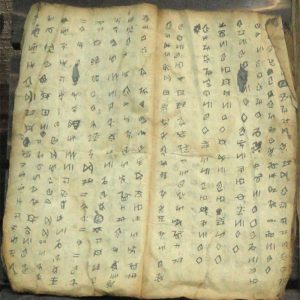The Epopee “Ashima” of Yi Ethnic Minority in Shilin County, Kunming
Ashima(阿诗玛), an epopee of Yi Ethnic Minority , is popular in Shilin Yi Autonomous County(石林彝族自治县) of Kunming. It is one of the Intangible Cultural Heritage in Yunnan, which reflects the history and legends of Yi people.
Brief Introduction
Ashima was originally sang in Yi language, before the 1950s, the Ashima singing in Sani Yi language is popular in Sani and Yi ethnic minority areas. The Chinese translation version and other forms of Ashima made a good impact at home and abroad after its publishing. However, The Sani language version Ashima is endangered in the Sani Yi ethnic area. Nowadays, there are few singers can sing Ashima in Sani language.
Story

Ashima tells the story about Ashima and Ahei in oral poetry and narrative melody. It depicts Ahei and Ashima’s perseverance in fighting against the powerful, and at last they become the echo in the mountains and the stone peaks in the stone forest. Their story left beauty to the world, shows that light will defeat darkness, beauty will overcome ugly and freedom will conquer oppression, which reflects the character and spirit of Sani people of the Yi Ethnic Minority. In the minds of Sani people, Ahei and Ashima are the symbols of hero and beauty.
Classification and Content
Ashima is divided into two schools, the southern school and the northern school. The southern school spread over Guishan township(圭山乡), Muzhuqing township(亩竹箐乡), Weize township(尾则乡). The northern school spread over Beidacun township(北大村乡), Xijiekou township(西街口乡), shilin town(石林镇). Both schools share some similarities. Ashima can be told or sung, singing is more often, there are solo, duet, a person led others follow several forms. Tunes include Xi tone(喜调), Old man tone(老人调), Sad tone(悲调), Crying tone(哭调), Scold tone(骂调), etc. Singers choose corresponding tunes according to their age and gender.
Ashima is sing by five words sentences(五言句), using the skills such as foreshadowing, hyperbole, irony, and so on. For the artistic form, it uses homophonic, anadiplosis, zeugma, simile and other skills. Ashima was singing in different occasions, mainly in the festivals, weddings, sacrifices, funerals, labor and daily life. Among them, Ashima is most sang in wedding.

Reputation
Since the publication of the Chinese edition in early 1950s, Ashima has been translated into English, French, German, Spanish, Russian, Japanese, Korean and other languages, spread all over the world. In China, it was adapted into a film, which is the first colorful wide screen stereo music musical film(彩色宽银幕立体声音乐歌舞片). It has also been adapted into Beijing Opera, Dian opera(滇剧), opera, dance drama, Sani opera(撒尼剧) and so on. The Chinese version was rated as China’s “Hundred Excellent Chinese Literature Books in the Last Century(百年百种优秀中国文学图书)” in the 20th century, and Ashima dance drama was rated as “Chinese dance classics of the 20th century(中华民族20世纪舞蹈经典)”. As a recognized outstanding work of Chinese folk literature, Ashima has been compiled into the textbook of folk literature for colleges and universities, collected in the authoritative dictionary Cihai(《辞海》) and Encyclopedia of China–Chinese Literature(《中国大百科全书·中国文学》).
Chinese Version: http://www.ynich.cn/view-ml-11110-1227.html
Translated by Emily -Wang/王海玲

 7 Days GolfingTour
7 Days GolfingTour
 8 Days Group Tour
8 Days Group Tour
 8 Days Yunnan Tour
8 Days Yunnan Tour
 7 Days Shangri La Hiking
7 Days Shangri La Hiking
 11 Days Yunnan Tour
11 Days Yunnan Tour
 6 Days Yuanyang Terraces
6 Days Yuanyang Terraces
 11 Days Yunnan Tour
11 Days Yunnan Tour
 8 Days South Yunnan
8 Days South Yunnan
 7 Days Tea Tour
7 Days Tea Tour
 8 Days Muslim Tour
8 Days Muslim Tour
 12 Days Self-Driving
12 Days Self-Driving
 4 Days Haba Climbing
4 Days Haba Climbing
 Tiger Leaping Gorge
Tiger Leaping Gorge
 Stone Forest
Stone Forest
 Yunnan-Tibet
Yunnan-Tibet
 Hani Rice Terraces
Hani Rice Terraces
 Kunming
Kunming
 Lijiang
Lijiang
 Shangri-la
Shangri-la
 Dali
Dali
 XishuangBanna
XishuangBanna
 Honghe
Honghe
 Kunming
Kunming
 Lijiang
Lijiang
 Shangri-la
Shangri-la
 Yuanyang Rice Terraces
Yuanyang Rice Terraces
 Nujiang
Nujiang
 XishuangBanna
XishuangBanna
 Spring City Golf
Spring City Golf
 Snow Mountain Golf
Snow Mountain Golf
 Stone Mountain Golf
Stone Mountain Golf











